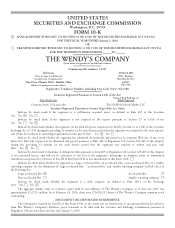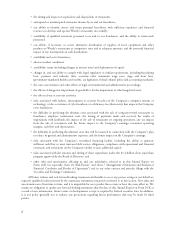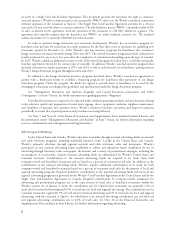Wendy's 2015 Annual Report Download - page 12
Download and view the complete annual report
Please find page 12 of the 2015 Wendy's annual report below. You can navigate through the pages in the report by either clicking on the pages listed below, or by using the keyword search tool below to find specific information within the annual report.International Operations and Franchising
As of January 3, 2016, Wendy’s had 403 franchised restaurants in 27 countries and territories other than the
United States and Canada. Wendy’s intends to grow its international business aggressively, yet responsibly. Since the
beginning of 2009, development agreements have been executed for Wendy’s locations to be opened in the following
countries and territories: Argentina, Azerbaijan, Chile, Dominican Republic, the Eastern Caribbean, Ecuador,
Georgia, Guatemala, India, Indonesia, Middle East, North Africa and Philippines. These development agreements
include rights for 22 countries in which no Wendy’s restaurants were open as of January 3, 2016. In addition to new
market expansion, further development within existing markets will continue to be an important component of
Wendy’s international strategy over the coming years. Wendy’s has granted development rights in certain countries
and territories listed under Item 2 of this Form 10-K.
Franchisees who wish to operate Wendy’s restaurants outside the United States and Canada enter into
agreements with Wendy’s that generally provide franchise rights for each restaurant for an initial term of 10 years or
20 years, depending on the country, and typically include a 10-year renewal provision, subject to certain conditions.
The agreements license the franchisee to use the Wendy’s trademarks and know-how in the operation of a Wendy’s
restaurant at a specified location. Generally, the franchisee pays Wendy’s an initial technical assistance fee or other per
restaurant fee and monthly fees based on a percentage of gross monthly sales of each restaurant. In certain foreign
markets, Wendy’s may grant the franchisee exclusivity to develop a territory in exchange for the franchisee
undertaking to develop a specified number of new Wendy’s restaurants in the territory based on a negotiated
schedule. In these instances, the franchisee generally pays Wendy’s an upfront development fee, annual development
fees or a per restaurant fee. In certain circumstances, Wendy’s may grant a franchisee the right to sub-franchise in a
stated territory, subject to certain conditions.
Wendy’s also continually evaluates non-franchise opportunities for development of Wendy’s restaurants in
other international markets, including through joint ventures with third parties and opening company-owned
restaurants.
General
Governmental Regulations
Various state laws and the Federal Trade Commission regulate Wendy’s franchising activities. The Federal
Trade Commission requires that franchisors make extensive disclosure to prospective franchisees before the execution
of a franchise agreement. Several states require registration and disclosure in connection with franchise offers and sales
and have “franchise relationship laws” that limit the ability of franchisors to terminate franchise agreements or to
withhold consent to the renewal or transfer of these agreements. In addition, Wendy’s and its franchisees must
comply with the federal Fair Labor Standards Act and similar state and local laws, the Americans with Disabilities Act
(the “ADA”), which requires that all public accommodations and commercial facilities meet federal requirements
related to access and use by disabled persons, and various state and local laws governing matters that include, for
example, the handling, preparation and sale of food and beverages, the provision of nutritional information on menu
boards, minimum wages, overtime and other working and safety conditions. Compliance with the ADA requirements
could require removal of access barriers and non-compliance could result in imposition of fines by the United States
government or an award of damages to private litigants. We do not believe that costs relating to compliance with the
ADA will have a material adverse effect on the Company’s consolidated financial position or results of operations. We
cannot predict the effect on our operations, particularly on our relationship with franchisees, of any pending or future
legislation.
Changes in government-mandated health care benefits under the Patient Protection and Affordable Care Act
(“PPACA”) are anticipated to continue to increase our costs and the costs of our franchisees. Our compliance with the
PPACA resulted in significant modifications to our benefits policies and practices. Because we experienced modest
enrollment and participation in our health plans by newly full-time employees in 2015, the cost increases did not
result in modifications to our business practices. However, future cost increases could be material and any future
compliance-related modifications to our benefits policies and practices, or to our business practices, could be
disruptive to our operations and impact our ability to attract and retain personnel.
9
























